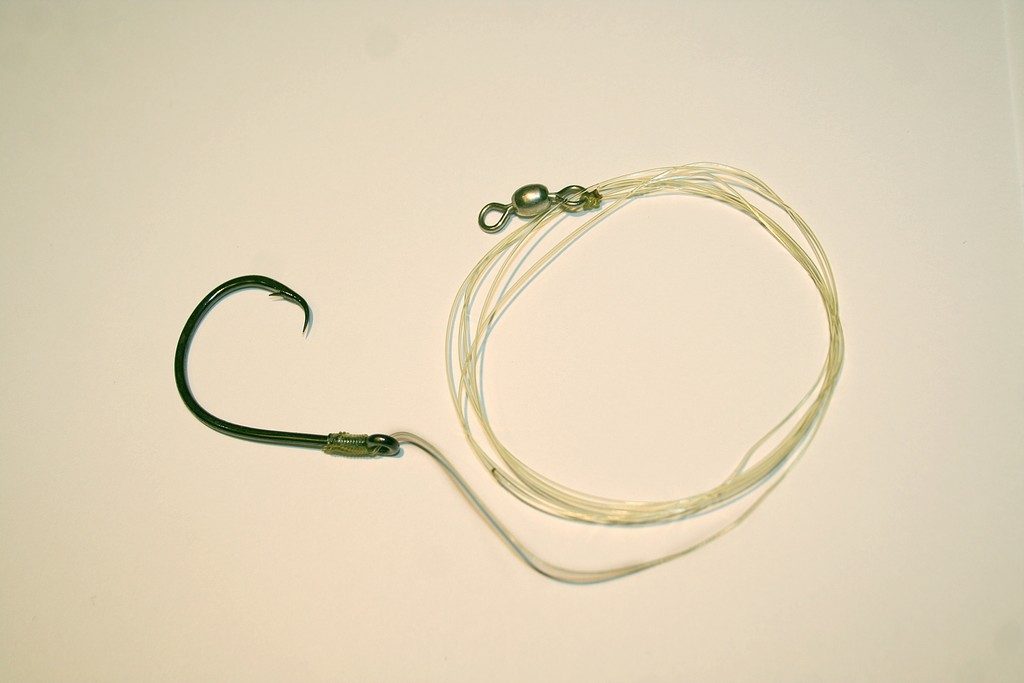by Jack Naves
Using bait is a great way to put fish into the boat when fishing for striped bass. Soaking bait works, but the biggest issue some anglers have is timing when to set the hook. They typically set the hook too soon, and end up ripping their bait off without hooking the fish.
Over the past several years, I’ve been doing a lot of experimentation with circle hooks. A circle hook looks similar to a conventional J-shaped hook, but the point curls around and aims at the shank. At first glance, it seems like you wouldn’t be able set the hook with these things. You would be correct, and this is where circle hooks deviate from J-hooks. With circle hooks, the hook is pulled into the corner of the fish’s mouth by reeling slowly. Instead of swinging for the sky like one of those bass fishing shows, you slowly reel to set the hook.
For hooks, I’ve settled on Gamakatsu 8/0 inline octopus circle hooks with a straight eye (265418 INLINE OCTOPUS CIRCLE SE). I use a three-foot long 25-pound test P-Line CXX monofilament leader. I tie a snell knot so the leader comes out of the eye on the same side as the hook point. This forces the hook point towards the line when you hook a fish. I found this to be the recommended method by a commercial fishing website that had a bunch of test data to support the method.
If you think using circle hooks for stripers sounds crazy, wait until you hear what kind of rod I am using. Long limber rods help to read the bites and load up on the hooksets. Ugly Sticks or downrigger rods seem to work nicely, but I’ve settled on the 10 foot “B’n’M West Point Crappie Pole” as my favorite rod. Yes, a crappie rod for stripers. I’ve caught fish up to 21 pounds on these rods. I like to use 65-pound test braided line for my mainline, as it doesn’t stick to the rod blank as bad as mono does when loaded up on a fish.
As for bait, anything will do, just be sure that you don’t block the gap between the hook point and the shank. I like to allow the bait to hang freely from the bend of the hook. Stripers aren’t hook-shy, so don’t worry about hiding the hook inside of the bait. I’ve had success using shad, pile worms, sardines, and anchovies, but chicken livers are my favorite when using circle hooks.
When using baits like whole shad or anchovies, the baits have a tendency to slide up the shank and block the gap or foul the hook point. To compensate for this, slide a bait button either side of the bait to pin it to the bend of the hook. With soft baits like chicken livers, just glob the bait onto the hook and secure it with some elastic thread.
Rig up with a typical sliding-sinker setup. Clip on a sinker just heavy enough to hold the bait to the bottom. Typically, two to four ounces will do. Next, bait your hook and cast out. Put the rod in a fixed holder at a 45-degree angle to the sky, and keep the reel in gear with a fairly tight drag.
When the fish takes the bait, and swims off, it will hook itself when the line pulls tight. This is really helpful for kids or beginners who don’t have experience with setting the hook at the right time. Just put the rods in holders as if you are trolling and let the fish do the work.
I have a rule that the rod doesn’t come out of the holder until the fish is hooked and loaded up. If a bite lasts more than about five seconds, I slowly reel with the rod still in the holder. If the fish drops the bait I stop and they usually come back. Once the rod doubles over, you know you are hooked up and can pull the rod out to fight the fish. The key to circle hooks is that you DO NOT SET THE HOOK. Just slowly reel until the fish is really loaded up and clearly hooked.
If you get bit but the fish doesn’t take the bait, try dragging your bait across the bottom very slowly a few feet at a time. If you don’t get bit, peel out a few feet of line to allow your bait to drift back. Pause for about twenty seconds and repeat. In many cases, the fish will start biting while the bait is in motion. When this happens, slowly pull the bait forward until the fish loads up on the hook. If they drop it, just peel out some line and they will come back.
You’ll be surprised at how many times nibble bites you thought were shakers turn out to be big stripers mouthing at the bait without running with it. I think this is the biggest advantage of circle hooks over conventional J-hooks. You will turn unsuspecting nibbles into hookups.
During the winter when the water temperature is below 52 degrees, slowly pull the bait forward whenever you get a tap. The cold water makes the fish less aggressive and they will rarely run with the bait. In cold water, I downsize my baits and use smaller 6/0 circle hooks. Sometimes I will switch over to 3/0 J-Hooks when the winter bite gets really slow.
Now that I have switched to circle hooks, I will never go back. I’ve caught way more stripers than I ever did using J-hooks and rod balancers. The tips I’ve outlined here should help you to increase your hookup ratios, especially if you are a beginner or have kids. Try running circle hooks on one of your rods and compare the results. I hope that you will be just as surprised as I was.


